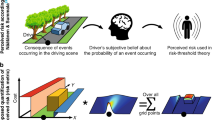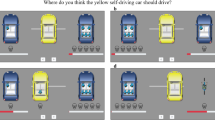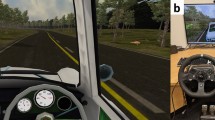The temptation to change lanes on a motorway may be prompted by an illusion.
Abstract
Switching lanes while driving along a busy road can be a risky manoeuvre. It is often instigated on the driver's judgement that the cars in the next lane are moving faster than those in the driver's own lane. But faulty intuition1,2,3 may cause people to overestimate the speed of vehicles in the next lane, believing that they are moving faster even when both lanes have the same average speed. We suggest that this illusion occurs because more time is generally spent being overtaken (passed) by other vehicles than is spent in overtaking them. Knowing that this effect is illusory might encourage drivers to resist small temptations to change lanes.
Similar content being viewed by others
Main
We used computer simulations to create two lanes of traffic with identical characteristics, except that their congestion varied depending on random starting gaps. Vehicles then accelerated if no other vehicle was within the minimum headway distance, otherwise they decelerated. Minimum headway distances increased with higher velocities to prevent collisions.
We evaluated statistically the movements of an individual driver compared with all the others in the next lane. Under baseline conditions, many one-second epochs produced a change in the driver's relative position. Epochs in which the index vehicle was overtaken were more frequent than epochs in which the index vehicle was overtaking another vehicle (Fig. 1). The total number of vehicles that passed the driver was balanced by the total number of vehicles that were overtaken by the driver because of multiplicity in some epochs.
All time estimates have standard errors of less than 5 seconds that decrease with traffic density. For example, a driver travelling for 10 minutes on a roadway with congestion of about 100 vehicles per kilometre would spend 47 seconds being overtaken by vehicles in the other lane and about 35 seconds overtaking vehicles in the other lane if both lanes have the same average speed. Details of simulation models are available from the authors.
Doubling the acceleration generated a larger difference, and halving the minimum headway distance, to represent ‘tailgating’, greatly increased the difference. Reducing the frequency with which the index driver glanced at the next lane from once every second to once every two seconds attenuated the difference. No combination yielded a slower apparent speed for the next lane.
We also videotaped traffic sequences by mounting a camera in a moving vehicle and filming the side-view perspective of the next lane on a congested road. When a section of videotape showing a slightly slower average speed in the next lane was screened to driving students (n=120), 70% stated that the next lane was moving faster and 65% said they would change lane if possible.
From these results, we suggest that drivers are responding to an illusion: namely, that the next lane on a congested road appears to be moving faster than the driver's present lane, even when both lanes have the same average speed. This occurs because vehicles spread out when moving quickly and pack together when moving slowly. A driver can therefore overtake many vehicles in a brief time interval, but it takes much longer for the driver to be overtaken by the same vehicles.
Other aspects of human perception may accentuate the impression that the next lane is moving faster. Differential surveillance can occur because drivers look forwards rather than backwards, so vehicles that are overtaken become invisible very quickly, whereas vehicles that overtake the index driver remain conspicuous for much longer4. Moreover, a driver is more likely to glance at the next lane for comparison when he is relatively idle5 while moving slowly.
Even if attention was not focused in particular directions and was evenly spaced in time, human psychology may make being overtaken (losing) seem more salient than the corresponding gains6. Furthermore, misconceptions about randomness can make runs of overtaking and being overtaken seem unduly prolonged7,8. Our study highlights the effects of congestion and the increasing importance of the illusion, given that the number of miles travelled by vehicles is increasing at a much faster rate than the amount of roadway9,10.
References
Snowden, R. J., Stimpson, N. & Ruddle, R. A. Nature 392, 450 (1998).
Walton, D. & Bathurst, J. Accident Anal. Prevent. 30, 821–830 (1998).
Tversky, A. & Kahneman, D. Q. J. Econ. 107, 1039–1061 (1991).
Larson, R. C. Operat. Res. 35, 895–904 (1987).
Angrilli, A., Cherubini, P., Pavese, A. & Manfredini, S. Percept. Psychophys. 59, 972–982 (1997).
Tversky, A. & Kahneman, D. Science 185, 1124–1131 (1974).
Gilovich, T., Vallone, B. & Tversky, A. Cogn. Psychol. 17, 295–314 (1985).
Feller, W. An Introduction to Probability Theory and its Applications Vol II (Wiley, New York, 1966).
Helbing, D. & Huberman, B. A. Nature 396, 738–740 (1998).
Bureau of the Census Statistical Abstract of the United States 1996 116th edn (Government Printing Office, Washington DC, 1997).
Author information
Authors and Affiliations
Corresponding author
Rights and permissions
About this article
Cite this article
Redelmeier, D., Tibshirani, R. Why cars in the next lane seem to go faster. Nature 401, 35 (1999). https://doi.org/10.1038/43360
Issue Date:
DOI: https://doi.org/10.1038/43360
This article is cited by
-
Vigour of self-paced reaching movement: cost of time and individual traits
Scientific Reports (2018)
Comments
By submitting a comment you agree to abide by our Terms and Community Guidelines. If you find something abusive or that does not comply with our terms or guidelines please flag it as inappropriate.




